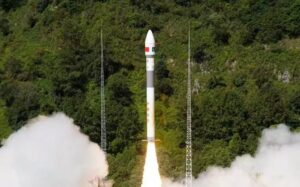NASA has awarded new funding to 11 U.S. companies to develop technologies that could support long-term exploration on the Moon and in space.
The projects will be funded jointly by NASA and industry partners. The total expected NASA contribution is $150 million across all 11 companies as part of the space agency’s Tipping Point program. A technology is considered at a Tipping Point if the agency’s investment can help grow the innovation into a viable commercial solution.
“Partnering with the commercial space industry lets us at NASA harness the strength of American innovation and ingenuity,” said NASA Administrator Bill Nelson. These technologies have the potential to be the foundation of future exploration, he added.
Prasun Desai, the acting associate administrator for NASA’s Space Technology Mission Directorate (STMD), said that awards are meant “to push crucial technologies over the finish line so they can be used in future missions.” He said that “Our partnerships with industry could be a cornerstone of humanity’s return to the Moon under Artemis”.
Awarded companies and projects
Each company will contribute a minimum of 10-25% based on company size, of the total project cost. These companies include:
Astrobotic Technology of Pittsburgh — $34.6 million
Astrobotic will demonstrate power transmission on the lunar surface. A CubeRover will deploy 1 kilometer of cable from an Astrobotic lunar lander and receive the first high-voltage power transmitted through a cable across the lunar surface. The demonstration will advance power generation and distribution technologies, including – a high-voltage power converter, cable, and cable reel system.

Big Metal Additive of Denver — $5.4 million
The company will advance materials, manufacturing processes, equipment, and facilities for metal hybrid additive manufacturing. the Big Metal Additive system will help increase technology readiness and reduce lead time, material waste, and cost to enable a range of structural products, including space habitats.
Blue Origin of Kent, Washington — $34.7 million
This company will advance an end-to-end in-situ resource utilization (ISRU) system that can extract oxygen, iron, silicon, and aluminum from lunar regolith simulant and use the extracted materials to produce solar cells and wire. Based on a process called molten regolith electrolysis, the tech would bootstrap unlimited electricity and power transmission cables anywhere on the surface of the Moon, according to Blue Origin. This process also produces oxygen as a useful byproduct for propulsion and life support.
Freedom Photonics of Santa Barbara, California — $1.6 million
This company will develop a novel direct diode laser sour that could enable more efficient lidar systems. The system could better detect methane in Earth’s atmosphere and improve scientists’ understanding of climate change.
Lockheed Martin of Littleton, Colorado — $9.1 million
Lockheed Martin will demonstrate in-space component joining and inspection technologies for structural, electrical, and fluid systems. The capability would reduce risk and advance the maturity and reliability of in-space assembly architectures.
Redwire of Jacksonville, Florida — $12.9 million
Redwire is a leader in space infrastructure for the next-generation space economy. Their cutting-edge manufacturing technology will use a microwave emitter to heat and solidify regolith (lunar dust and crushed rock) to construct landing pads, roads, foundations, and dust mitigation surfaces. The technology will be scalable to lunar rovers, vehicles, and robotic arms.

Protoinnovations of Pittsburgh — $6.2 million
This company will advance modular, flight-ready mobility control software for future lunar rovers and robots. ProtoInnovations has over 15 years of experience in developing novel technologies, focusing on high-performance robust prototype robots, autonomy software, and mechatronics development.
Psionic of Hampton, Virginia — $3.2 million
Partnering with Draper Laboratory in Cambridge, Massachusetts, Psionic will conduct a flight demonstration of its latest generation Navigation Doppler Lidar and terrain contour matching system. Crewed and robotic missions could utilize the high-precision navigation system to land at various planetary destinations, including the Moon.
United Launch Alliance (ULA) of Centennial, Colorado — $25 million
The company will continue to evolve a proven Hypersonic Inflatable Aerodynamic Decelerator (HIAD) technology design. ULA will develop a larger 10-meter HIAD that leverages a two-piece structure to enable effective load distribution for even larger inflatable decelerators.
Varda Space Industries of El Segundo, California — $1.9 million
Varda will mature Conformal Phenolic Impregnated Carbon Ablator (C-PICA), a cost-effective and mass-efficient thermal protection system material developed by NASA. The project will flight test C-PICA and start commercial production of the material.
Zeno Power Systems of Washington, D.C. — $15 million
The company will develop a Stirling engine-enabled radioisotope power system that utilizes a long-lived, thermally constant heat source – Americium 241. Zeno Power technology could be used for space and surface power systems, offering an alternative to plutonium-based power systems.









